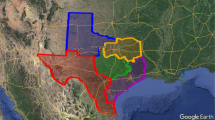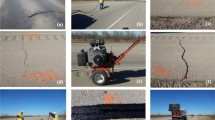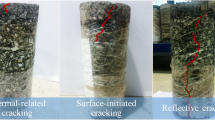Abstract
Crack sealing and filling treatments have always been an important consideration in order to prolong the life of pavement among all the pavement maintenance programs. Crack sealing uses a router to cut the crack to provide a uniform rectangular reservoir for greater penetration of sealants in order to have good bonding whereas crack filling is simply inserting sealant without performing any modification to the crack walls. This research study is intended to compare the initial and long-term environmental burdens between crack sealing and filling treatment. The parameters related to the field implementation of crack treatment methods (length sealed per day, amount of materials, configuration techniques, and equipment data) were collected from the Abilene district database system and the inventory loadings were gathered from the industry and the literature. Each life cycle phase of crack filling and sealing treatment was quantified in eight impact categories in terms of environmental emissions. In general the results of this study indicated that the initial environmental emissions of crack sealing treatment are very high compared to filling technique. However, this environmental burdens can be compensated along with an approximately 25% reduction in emissions by implementing crack sealing treatment over a long period.




Similar content being viewed by others
References
Santero NJ, Horvath A (2009) Global warming potential of pavement. Environ Res Lett 4:1–8
Hand AJ, Galal KA, Ward DR, Fang C (2000) Cost-effectiveness of joint and crack sealing: synthesis of practice. J Transp Eng 126(6):521–529
Cuelho E, Freeman RB (2004) Cost-effectiveness of crack sealing materials and techniques for asphalt pavements (No. FHWA/MT-04-006/8127). Montana Department of Transportation, Research Program
Masson JF, Boudreau S, Girard C (2003) Guidelines for sealing and filling cracks in asphalt concrete pavement
Weiland C, Muench S (2010) Life cycle assessment of portland cement concrete interstate highway rehabilitation and replacement. Washington State Department of Transportation Research Report, p 105
Chehvoits J, Galehouse L (2010) Energy usage and greenhouse gas emissions of pavement preservation processes for asphalt concrete pavements. In: First international conference on pavement preservation. Transportation Research Board, pp 27–42
Zhang H, Keoleian AG, Lepech MD (2008) An integrated life cycle assessment and life cycle analysis model for pavement overlay systems. In: Biondini F, Frangopol D (eds) Life-cycle civil engineering. Taylor & Francis Group, London, pp 1–5
Chappat M, Bilal J (2003) The environmental road of the future: life cycle analysis. In: Energy consumption and greenhouse gas emissions. Colas Group, pp 2–34
Theonux et al (2006) Energy consumption comparison for different asphalt pavements rehabilitation techniques used in Chile. Resour Conserv Recycl 49:325–339
Wang H, Gangaram R (2014) Life cycle assessment of asphalt pavement maintenance (No. CAIT-UTC-013). Center for Advanced Infrastructure and Transportation, Rutgers, The State University of New Jersey
Wang CP, Weisgerber FE (1993) Effects of seal geometry on adhesive stresses in pavement joint seals. Transp Res Rec 999:64–70
Ketcham SA (1996) Structural mechanics solutions for butt joint seals in cold climates. DTIC Document
Khuri FM, Tons E (1992) Comparing rectangular and trapezoidal seals using the finite element method. Transp Res Board 1334:25–37
Decker DS (2014) Best practices for crack treatments for asphalt pavements (No. Project 20-07)
Yildirim Y, Korkmaz A, Prozzi J (2006) Performance comparison of hot rubber crack sealants to emulsified asphalt crack sealants (No. FHWA/TX-06/0-4061-3)
Rajagopal A, Minkarah I, Green R, Morse AA (2003) Effectiveness of crack sealing on pavement serviceability and life (No. FHWA/OH-2003/009). Ohio Department of transportation
European Bitumen Association (2011) Life cycle inventory: bitumen
Stripple H (2001) Life cycle assessment of road: a pilot study for inventory analysis. IVL Swedish environmental research institute
Huang Y, Bird R, Heidrich O (2009) Development of a life cycle assessment tool for construction and maintenance of asphalt pavements. J Clean Prod 17:283–296
Acknowledgements
This study was conducted under research project “Development of High-Performance Concrete Pavement Maintenance Technology to Extend Roadway Life (Project No. 18TLRP-B146707-01)” funded by the Ministry of Land, Infrastructure and Transport (MOLIT) and the Korea Agency for Infrastructure Technology Advancement (KAIA). The authors would like to thank the members of research team, MOLIT and KAIA for their guidance and supports throughout the project.
Author information
Authors and Affiliations
Corresponding author
Rights and permissions
About this article
Cite this article
Mazumder, M., Sriraman, V., Kim, H.H. et al. Quantifying the environmental impacts of crack sealing and filling treatment in hot mix asphalt pavement. Innov. Infrastruct. Solut. 3, 61 (2018). https://doi.org/10.1007/s41062-018-0161-4
Received:
Accepted:
Published:
DOI: https://doi.org/10.1007/s41062-018-0161-4




